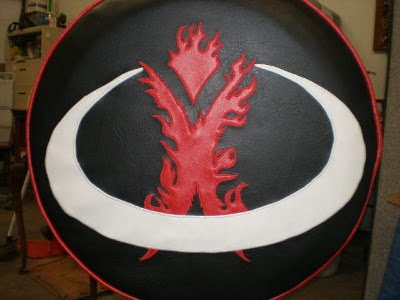 Oil on canvas, 24" x 30"
Oil on canvas, 24" x 30"
Saturday, January 30, 2010
Thursday, January 28, 2010
Easy A Team Art Car Project
The new A Team movie is coming out in June and with it will follow another wave of home made A Team vans. What's great about this particular art car project is that its easy to make and all you need is a black vehicle to start with. The only painting you have to do is the red stripe down the side and all you have to worry about is getting the angle right at the elbow, easy peasy.












Here is the original A Team intro video to get you psyched












Here is the original A Team intro video to get you psyched
Wednesday, January 27, 2010
Urban Trash Art Car from Brazil - Country covered in trash gets a makeover

This Urban Trash Art Car is brought to you by Urban Trash Art that I found via my new ACC central follower Rodrigo Machado who posted it on his blog. Not really a street legal art car due to the lack of any front or side impact safety zones. But it is a good use of trash and these guys go around Brazil and reconstruct trash into these amazing sculptures. I guess that means there is a lot of trash laying around Brazil. Nice work guys!!! Here is the video as well of the two gusy in action.
WILLIAM COTTON (1880-1958)

William Cotton trained as a fine artist at the Academie Julien in Paris. He exhibited at the Luxembourg Museum and other esteemed institutions, such as the Corcoran Art Gallery in Washington and the Art Institute of Chicago.
But Cotton's gallery paintings-- consistent with the fashion of his day-- often looked like sappy Victorian Valentines. They are mercifully forgotten today.

In the 1930s, Cotton turned from gallery painting to illustration and began doing caricatures of Broadway stars, writers and politicians for Vanity Fair and the New Yorker. For the first time, Cotton was forced to accept the subjects that editors assigned to him. He was forced to work on deadline. He no longer had the luxury of unlimited space to paint fancy lace collars and detailed fabric. Instead, he was forced to cut to the essentials, and simplify his images for reproduction on a small magazine page. The result was a long series of really neat, beautifully colored caricatures:




Cotton quickly became one of the most famous caricaturists of the 1930s. His artwork was seen by tens of thousands of people. Eleanor Roosevelt called his Vanity Fair portrait of her, "my favorite character picture."
I love the colors and bold simplification of forms in these pictures. For me, they are far superior to Cotton's gallery work. The relentless efficiency of the marketplace scrubbed away a lot of frills and pretensions, leaving Cotton's work clear, robust and decisive.
We love to be outraged when tasteless commercial sponsors impose restrictions on talented artists. Yet, nobody talks about the other side of the coin: artists whose mediocre "fine" art was improved by the challenges and limitations of commercial media and commercial audiences. It does happen, and we should keep our eyes and our minds open for it.
Those cold blooded market forces do a lot of damage, but there can also be value in keeping art employed in the service of commerce (just as the very first art was employed in the service of the hunt, back in the Cromagnon era). Art that serves no purpose other than to hang as an object on a museum wall often suffers because it is not integrated into daily life. That's one reason I have such a soft spot in my heart for illustration.
Tuesday, January 26, 2010
The Mystery-Mobile Art Car
The Mystery-Mobile art car covered in Mystery Spot stickers was unveiled recently, yet it is still a mystery as to who owns this art car.
Monday, January 25, 2010
Mercedes Bonz Art Car - New meaning to the word road kill
This Volvo is covered in hundreds of bones is called the Mercedes Bobz. Road kill just took a different meaning.
Labels:
Mercedes Bonz,
Objects Glued,
organic,
Sedan,
USA,
Volvo
Saturday, January 23, 2010
Thursday, January 21, 2010
Art Showing: Ombu Salon + Spa
Tuesday, January 19, 2010
ART vs. LIFE

Art is a double edged sword. It enhances our experience of life, but also obstructs and diminishes it.
We spend most of our time here at the good ol' Illustration Art blog focusing on that enhancement part, but today as a special public service we offer some thoughts on that dark side of art-- the part they never mentioned in your high school Art Appreciation class.
Goethe wrote about how the arts make us more sensitive. In The Sorrows of Young Werther, he described a young couple in love, visiting the countryside:
We went to the window. It was still thundering at a distance: a soft rain was pouring down over the country, and filled the air around us with delicious odours. Charlotte leaned forward on her arm; her eyes wandered over the scene; she raised them to the sky, and then turned them upon me; they were moistened with tears; she placed her hand on mine and said, “Klopstock!”This reference to the poet Friedrich Gottfried Klopstock (1724-1803) was enough to cause our hero to quiver with emotion:
At once I remembered the magnificent ode which was in her thoughts: I felt oppressed with the weight of my sensations, and sank under them. It was more than I could bear. I bent over her hand, kissed it in a stream of delicious tears, and again looked up to her eyes. Divine Klopstock!Now, I'm a fan of cultural refinement just as much as the next guy, but when sensitivity is left to run rampant, it can become downright debilitating. Goethe's tribute leaves me gasping for air.
There's no shortage of examples of art getting in the way of life. Consider the young males out there fixating on the art of bosomy space vixens in garter belts and spiked heels. This is a dandy pastime (I can personally testify) but after a certain point collecting such images in computer games, art portfolios and limited edition giclee prints distracts the viewer from real life relationships. If we let such art distort our values and expectations, we may find ourselves with only deluxe coated archival paper stock to fondle. Art can lure us away from Ruskin's principle that "the only wealth is life."
This did not escape the attention of Walt Whitman, who asked: "Have you reckon'd that the landscape took substance and form that it might be painted in a picture?"
Here, Ronald Searle shows us someone who apparently got the answer wrong:

It seems to me that there is a bargain between art and life. To derive the most from art, we should keep the trade offs of that bargain freshly in mind:
- Art robs us of time, but with the promise that it will pay us back by saving us time later. In theory, art will mature us, enrich us, and educate us faster than we could ever experience just by living our solitary lives. It will expose us to a wider range of perspectives than we could ever experience in real time.
- Art comes between us and the immediacy of experience, but with the promise that its filters will enrich the way we perceive those experiences.
- Art tells us lies (often starting with the illusion of 3D on a 2D surface) with the promise that those lies will eventually help us see the truth more clearly.
- Art is supposed to sensitize us, but as Werther demonstrated, it's possible to become too sensitive. There are a lot of complex, high strung people out there whose refined palates do them no good at all. They have trouble getting pleasure out of life or having good relationships; you see them picking at everything, having lost the ability to take pleasure in the merely nice.
I try to keep in mind the wise philosophy of Lionello Venturi, who wrote:
What ultimately matters in art is not the canvas, the hue of oil or tempera, the anatomical structure and all the other measurable items, but its contribution to our life, its suggestions to our sensations, feeling and imagination.
Saturday, January 16, 2010
Thursday, January 14, 2010
Darth Vader Tire Cover for Sale
I recently came across a web site that make Custom Tire Covers called Threads to Treads. If you have an exposed spare tire you want to protect from the weather and add some artistic flaire, this is the way to go. They are made by the "Sweat Shop Girls" in Redding, California and the only limits is your imagination, so get yours today. Below are the ones available for sale and my all time favorite is the Darth Vader one, and if you like these they have more in flickr.
1) Darth Vader Tire Cover

1) Darth Vader Tire Cover

Monday, January 11, 2010
7 ways to save big with half a car in 2010
2010 might turn out to be another financially difficult year so I came up with seven ways to save on you car bill in 2010. By getting half a car this year you will be saving a ton of money and doing your part in the fight against global warming. You will also enjoy other benefits that you might never have though of before like more ventilation, access to carpool lanes and the ability to plow a corn field. It will difficult at first to drive with only two front wheels but over time this too will become a problem of the past. To start things off here is a great video of a half car expert demonstrating its capabilities, in case you still have doubts.
Here are 7 ways to save big with half a car in 2010
1) Half car saves on drive through costs by cooking in your car

2) Half car saves a ton on see's candies and flowers after the divorce papers go through

3) Half car saves on moving costs with plenty of trunk space

4) Half car saves on the price of a full size car

5) Half car saves on gas with smaller a engine

6) Half car saves on speeding tickets

7) Half car gets more horse power with reduced emissions

Here is more half car videos just in case you cant get enough!!!
Here are 7 ways to save big with half a car in 2010
1) Half car saves on drive through costs by cooking in your car

2) Half car saves a ton on see's candies and flowers after the divorce papers go through

3) Half car saves on moving costs with plenty of trunk space

4) Half car saves on the price of a full size car

5) Half car saves on gas with smaller a engine

6) Half car saves on speeding tickets

7) Half car gets more horse power with reduced emissions

Here is more half car videos just in case you cant get enough!!!
FRANK BRANGWYN (1867-1956)
Frank Brangwyn had a special talent for depicting grand structures such as cathedrals, bridges and ships.


He drew individual human beings the same way, as if they were monumental structures. He posed and rendered them with the kind of weight, grandeur and dignity he would have applied to a cathedral:




Brangwyn had an excellent eye for the glories of the secular world; he was able to show the magnificence-- and even the divinity-- of laborers working in a shipyard. That's part of what made his work so appealing to the public. However, he did not lead a particularly religious life.
Then, while he was still at he peak of his powers, Brangwyn became more interested in formal religion, and from the 1930's on, "devoted himself to religious art."
Biographer Libby Horner offered one explanation for Brangwyn's transformation:

As you can see from the drawings in the Auad portfolio, Brangwyn never lost his gift for classical staging of figures:



The newly religious Brangwyn drew himself into a number of these drawings. Clearly he was wrestling with a lot of issues.

Brangwyn was internationally famous during his lifetime, but as he aged, the modern art world passed him by. Scholars will tell you that modern artists and writers became embittered by the horrors of World War I and the hard lesson that modern science would not necessarily be a tool for progress. Brangwyn's triumphal style gave way to abstraction and art that questioned fundamental principles of western civilization.
The once gregarious artist, who had found such glory in the secular world, led an increasingly reclusive and superstitious life and died in 1956.


He drew individual human beings the same way, as if they were monumental structures. He posed and rendered them with the kind of weight, grandeur and dignity he would have applied to a cathedral:




Brangwyn had an excellent eye for the glories of the secular world; he was able to show the magnificence-- and even the divinity-- of laborers working in a shipyard. That's part of what made his work so appealing to the public. However, he did not lead a particularly religious life.
Then, while he was still at he peak of his powers, Brangwyn became more interested in formal religion, and from the 1930's on, "devoted himself to religious art."
Biographer Libby Horner offered one explanation for Brangwyn's transformation:
As the artist grew older and faced mortality he produced more religious works in which he frequently included his own image as if he feared retribition for having been a "bad lot" and, in his own superstitous manner, was hoping to redeem himself.I was reminded of Brangwyn when I received the new portfolio of his illustrations of the Stations of the Cross from Auad Publishing (the publisher responsible for the forthcoming book on the illustrator Robert Fawcett).

As you can see from the drawings in the Auad portfolio, Brangwyn never lost his gift for classical staging of figures:



The newly religious Brangwyn drew himself into a number of these drawings. Clearly he was wrestling with a lot of issues.

Brangwyn was internationally famous during his lifetime, but as he aged, the modern art world passed him by. Scholars will tell you that modern artists and writers became embittered by the horrors of World War I and the hard lesson that modern science would not necessarily be a tool for progress. Brangwyn's triumphal style gave way to abstraction and art that questioned fundamental principles of western civilization.
The once gregarious artist, who had found such glory in the secular world, led an increasingly reclusive and superstitious life and died in 1956.
Subscribe to:
Comments (Atom)










